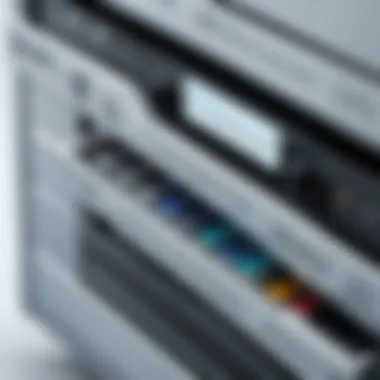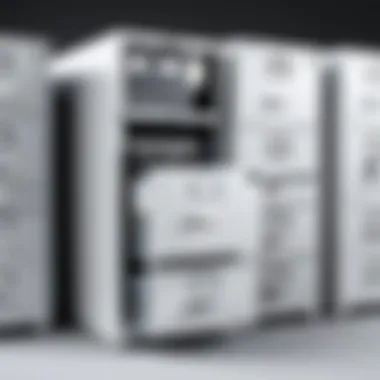E-Filing Cabinets: Transforming Document Management


Intro
In today's digital age, the management of documents has undergone a significant transformation. Traditional filing systems, often cumbersome and inefficient, have given way to innovative solutions that cater to the demands of modern workplaces. Among these solutions, e-filing cabinets stand out as key players in enhancing operational efficiency and security. They simplify the storage, retrieval, and sharing of documents, making them indispensable tools for businesses across various sectors. Understanding the features and benefits of e-filing cabinets is essential for decision-makers aiming to improve their organizations' document management processes.
Features Overview
E-filing cabinets come equipped with various functionalities that make them effective for document management. The technological advancements have encouraged the incorporation of features that address different needs. Here are some key aspects to consider:
Key Functionalities
- Document Storage: E-filing cabinets provide cloud-based storage options. This allows users to store an extensive range of documents securely without physical space constraints.
- Search and Retrieval: Advanced search functionalities enable users to locate documents quickly. This feature can drastically reduce the time spent on document management tasks.
- Access Controls: E-filing cabinets often include user access controls. Administrators can set permissions to ensure that only authorized personnel can view or edit specific documents.
These functionalities contribute greatly to overall productivity and help organizations respond promptly to market demands.
Integration Capabilities
Integration is a notable strength of e-filing cabinets. They can connect with other software solutions, enhancing their usability. Common integration capabilities include:
- Collaboration Tools: E-filing cabinets can integrate with platforms like Microsoft Teams and Slack. This promotes seamless collaboration among team members.
- CRM Systems: Integration with customer relationship management systems can streamline workflows, allowing for better management of client documentation.
- Accounting Software: Linking e-filing cabinets with accounting tools simplifies the management of financial records, facilitating compliance and reporting tasks.
The capacity to integrate these solutions enhances the overall document management experience by creating a more cohesive working environment.
Pros and Cons
When evaluating e-filing cabinets, it is crucial to consider not only their advantages but also potential drawbacks.
Advantages
- Cost-Effective: By reducing physical storage needs, e-filing cabinets can lead to significant savings in terms of rent or costs associated with maintaining physical records.
- Environmentally Friendly: Reducing paper usage promotes sustainability, aligning with corporate social responsibility goals.
- Enhanced Security: Digital documents can often be more secure than paper records. Encryption and regular backups protect vital business information from unauthorized access and data loss.
Disadvantages
- Technical Challenges: Organizations may face technical difficulties during implementation. Staff training is necessary, which can lead to initial disruptions.
- Dependence on Technology: Relying on digital systems means that any technological failures can temporarily hinder access to important documents.
Understanding both sides of the equation allows organizations to make informed decisions regarding their document management strategies.
"E-filing cabinets not only improve efficiency but also redefine how we approach document management in business."
In summary, e-filing cabinets represent a substantial advancement in document management solutions. As businesses continue to navigate the complexities of the digital landscape, these tools offer critical advantages in terms of organization, accessibility, and functionality. Key considerations, such as integration capabilities, will also influence the choice of the right e-filing solution tailored to specific business needs.
Preface to E-Filing Cabinets
In today's digital age, the efficiency of document management is paramount, and e-filing cabinets are at the forefront of this transformation. These solutions have become essential tools for organizations seeking to enhance their operations. The shift from traditional paper filing systems to electronic storage has implications for security, accessibility, and environmental sustainability.
E-filing cabinets allow businesses to store, manage, and share documents electronically. This technology eliminates the physical constraints of paper archives. It also provides flexibility, as documents can be accessed from various devices, promoting remote work and collaboration.
Importance of E-Filing Cabinets
The importance of e-filing cabinets cannot be understated. With the growing reliance on digital information, organizations face pressures to manage their data securely and efficiently. E-filing cabinets address these challenges by:
- Streamlining workflows: Automated processes accelerate the retrieval and storage of documents. This leads to time savings for employees who spend less time searching for files.
- Enhancing security: Digital storage can offer advanced security measures such as encryption and user access controls, protecting sensitive information from unauthorized access.
- Reducing costs: Transitioning to electronic filing reduces expenses associated with paper, ink, and physical storage spaces. Businesses can allocate resources towards more strategic initiatives.
- Facilitating compliance: Many industries require adherence to strict regulations. E-filing solutions often incorporate compliance features that assist organizations in meeting legal obligations concerning document retention and access.
Overall, e-filing cabinets represent a critical advancement in document management. As we explore their core features and advantages, we will uncover how they revolutionize business operations across various sectors.
"The transition to e-filing not only satisfies current demands for efficiency but also sets a foundation for future digital innovations."


Understanding the Concept of E-Filing
In the landscape of modern document management, grasping the concept of e-filing is crucial. E-filing cabinets are not simply digital repositories; they are integral systems designed for the efficient storage, retrieval, and management of documents in an increasingly digital world. As organizations move away from traditional paper-based systems, understanding how e-filing works can streamline processes and improve productivity dramatically.
E-filing cabinets bring together multiple functionalities that cater to the various needs of businesses. Their primary purpose is to provide a centralized location for storing documents securely and accessibly. This eliminates the inefficiencies and risks often associated with physical filing systems. The concept emphasizes not just holding files but making them actionable and easier to manipulate. Users can save time through quick searches, categorize documents accordingly, and implement robust user access controls.
The transition towards e-filing also underscores the importance of data management in today’s digital age. Data governance, compliance with regulations, and secure access are crucial elements that every enterprise needs to consider. The adoption of e-filing systems can significantly improve compliance with legal requirements, enhance security protocols, and reduce the time spent on document-related tasks.
"E-filing transforms the way organizations handle data, making it safer and easier while empowering collaboration among team members."
Definition and Purpose
E-filing cabinets refer to digital systems that allow users to store, manage, and access documents electronically. Their purpose is multi-faceted, encompassing the efficient preservation of important files and enhancing accessibility. These systems also promote environmental sustainability by reducing the need for paper storage and minimizing physical waste. The effective use of an e-filing cabinet ensures that documents can be retrieved quickly and shared among team members effortlessly. In competitive fields, such efficiency can set a business apart, ensuring it responds swiftly to changing demands and client needs.
Historical Context
The evolution of document management systems has been profound. Traditionally, companies relied on physical storage for important documents, which posed challenges including space constraints, security risks, and lengthy retrieval times. The advent of computers and the internet in the late 20th century marked a significant shift. Early digital filing systems laid the groundwork for modern e-filing cabinets, introducing concepts of scanned documents and electronic storage. Over the years, technological advancements like cloud computing and enhanced security protocols have further transformed how organizations manage documents. Today’s e-filing solutions are a culmination of decades of progress in technology and an increasing recognition of the need for efficiency and security in business operations.
Core Features of E-Filing Cabinets
E-filing cabinets play a crucial role in modern document management. They provide businesses with structured ways to store, access, and manage files electronically. Understanding the core features is essential. Each feature serves specific needs and vastly improves operational efficiency. The following sections will explore these features in depth.
Document Storage and Retrieval
E-filing cabinets allow users to store documents digitally, which significantly reduces physical storage needs. This feature also promotes better organization. Files can be categorized and tagged for easier access. When a user wants to find a specific file, the search process is quicker compared to traditional filing systems.
Cloud-based storage enables easy access from multiple devices. This flexibility means that remote work is feasible, and team members can retrieve documents anytime, anywhere. Moreover, the risk of losing important files due to physical damage or misplacement is minimized.
User Access Management
Controlling access to documents is a vital part of e-filing cabinets. User access management allows administrators to set permissions for different users. This means sensitive documents can be kept secure from unauthorized access.
By creating roles and permissions, businesses can ensure that only specified individuals can view or edit certain documents. This feature supports compliance with data protection regulations, critical for industries handling sensitive data. Additionally, it facilitates accountability, as tracking user actions becomes possible, which is difficult in paper-based systems.
Integration with Other Software
One notable advantage of e-filing cabinets is their ability to integrate seamlessly with other software. This interoperability is essential for businesses that rely on various applications for operations. For instance, e-filing systems can connect with customer relationship management software or enterprise resource planning systems.
Such integration eliminates data silos and enhances productivity. Users can access related documents without switching platforms. Moreover, this alignment helps maintain data consistency across applications, which is vital for informed decision making.
Search Functionality
A strong search functionality is one of the defining traits of e-filing cabinets. It allows users to input keywords or phrases and quickly find relevant documents. Advanced search options can also include filtering by date, file type, or tags. This is a considerable upgrade from traditional filing, where finding a document could take hours.
With robust search capabilities, teams can respond more efficiently to inquiries and meet deadlines. Moreover, it enhances collaboration, as team members spend less time searching for documents and more time on tasks that require their expertise.
"The shift from paper to electronic filing systems is not just a trend, but a necessity for businesses wanting to maintain efficiency and security in document management."
Overall, the core features of e-filing cabinets are pivotal for enhancing organizational capabilities. Document storage and retrieval, user access management, software integration, and effective search functionality all contribute to a streamlined document management process.
Advantages of Using E-Filing Cabinets
E-filing cabinets offer numerous advantages over traditional paper filing systems. As businesses move deeper into the digital age, the benefits of adopting e-filing solutions are becoming increasingly clear. These advantages encompass enhanced security, cost efficiency, improved collaboration, and space optimization. Each element contributes to a more streamlined and effective document management process.
Enhanced Security


One of the primary concerns in any business is the security of sensitive information. E-filing cabinets significantly reduce the risk of unauthorized access. Traditional paper files can be easily misplaced, stolen, or destroyed by environmental factors. In contrast, e-filing cabinets provide a secure digital environment, often utilizing encryption protocols to protect data.
Furthermore, user access management features allow administrators to control who has permission to view or edit specific documents. This tiered access enhances confidentiality and ensures that only authorized personnel can access critical files. Using regular backups also minimizes the risk of data loss due to unforeseen circumstances. E-filing systems, therefore, not only safeguard sensitive information but also ensure compliance with industry standards.
Cost Efficiency
The cost implications of transitioning to e-filing cabinets can lead to significant savings over time. Companies can reduce expenses related to physical storage, such as filing cabinets, paper, and printing costs. Additionally, there are savings associated with space. Businesses often incur high costs for real estate and maintaining large physical storage areas for paper files, which can be eliminated or significantly reduced with e-filing.
Moreover, e-filing cabinets enable process automation, which can streamline workflow. This automation can significantly cut down on labor costs associated with document retrieval, filing, and management. By reducing overhead costs, e-filing solutions enable businesses to allocate resources to more strategic initiatives.
Improved Collaboration
In today's fast-paced work environment, collaboration is essential for success. E-filing cabinets foster better teamwork by providing easy access to documents for multiple users, regardless of their physical location. Employees can work on shared documents simultaneously, leading to faster project completion and better stakeholder engagement.
This shared access allows for real-time updates and annotations, preventing version control issues commonly faced with traditional files. Teams can communicate more effectively, as information is readily available. By removing silos of information, e-filing promotes transparency and facilitates a culture of collaboration.
Space Optimization
Physical storage takes up valuable office space that can be better utilized. E-filing cabinets help businesses reclaim this space. Instead of stacking papers in filing cabinets, businesses can store thousands of documents in digital formats securely.
Less paper usage contributes not only to a clean office environment but also to environmental sustainability. Fewer resources are needed for paper production, and waste management becomes easier when there is less physical trash to handle. Overall, e-filing cabinets allow companies to streamline their operations and utilize their physical space more effectively, leading to a more organized workplace.
"Adopting e-filing cabinets results in a more efficient, secure, and collaborative work environment, which is crucial for modern businesses."
In summary, the advantages of using e-filing cabinets are significant. Enhanced security ensures sensitive information is protected, while cost efficiency can lead to substantial financial savings. Improved collaboration allows teams to work more effectively, and space optimization results in a more organized workspace. As such, e-filing cabinets are not just a trend but a strategic investment for any business looking to thrive in the digital age.
Challenges and Considerations
While e-filing cabinets present numerous benefits, they also come with a series of challenges that organizations must face. Understanding these challenges is essential for effective document management. This section examines three critical areas: data migration issues, compliance and legal concerns, and user training and adoption. An informed approach to these challenges can significantly influence the success of e-filing implementation.
Data Migration Issues
Data migration is a significant step that demands attention during the transition to e-filing systems. Organizations often have large volumes of existing paper documents or legacy digital files that need to be converted into the new format. This process can present several complicating factors.
First, ensuring the integrity and accuracy of data during migration is vital. If data is wrongly formatted or lost, it could result in operational delays or legal challenges. A well-planned migration strategy must include testing phases where sample data is moved to check for inconsistencies.
Secondly, the time it takes to migrate data can vary greatly. Businesses must plan for potential downtimes or disruptions in workflows while data is transferred. Integrate successful timelines, resource allocation, and support systems to address these elements efficiently.
Compliance and Legal Concerns
When organizations switch to e-filing cabinets, they must navigate through complex compliance and legal landscapes. Different industries are subject to varying regulations concerning data management. For instance, healthcare information must comply with standards such as HIPAA, while legal firms need to ensure adherence to privacy laws. Failure to comply with these regulations could lead to heavy fines or legal actions.
It is crucial for organizations to conduct comprehensive audits prior to adopting an e-filing solution. Such audits should assess current data management processes and ensure the new system meets all regulatory requirements. Consulting with legal professionals on data storage protocols can also mitigate potential risks associated with non-compliance.
User Training and Adoption
Effective user training is essential for the successful integration of e-filing systems within any organization. Employees must be comfortable with new technologies to maximize the benefits of electronic document management. A common challenge is resistance to change; many staff members may feel overwhelmed or skeptical about transitioning from traditional filing methods.
Organizations should provide structured training programs that highlight the benefits and ease of use of the new e-filing system. This can include interactive workshops, hands-on sessions, and ongoing support from IT professionals. Feedback mechanisms can create an opportunity for users to voice concerns and suggest improvements.
Effective training not only eases the transition but also enhances productivity and reduces errors in document handling.
Choosing the Right E-Filing Solution
Selecting the proper e-filing solution is crucial for businesses aiming to optimize their document management processes. With a variety of offerings available, understanding which solution aligns with specific business needs can significantly affect operational efficiency, security, and overall productivity. Therefore, this section will address important factors to consider when making this choice, ultimately guiding decision-makers toward a suitable solution.


Identifying Business Needs
Evaluating business needs is the first step in choosing the right e-filing solution. Each organization has distinct requirements based on its size, industry, and workflow. Key considerations include:
- Volume of Documents: Assess how many documents need to be managed regularly. A high volume may necessitate a more robust solution.
- Type of Files: Different files may require different handling. Consider if the files are mainly images, videos, or other formats.
- Compliance Requirements: Some industries are bound by strict data compliance regulations. Understanding these can help in selecting a compliant solution.
- User Accessibility: Determine who needs access and how many users will use the system. This informs necessary features such as multi-user access and permission settings.
Understanding these elements can provide clarity in narrowing down options tailored to specific organizational needs.
Evaluating Software Features
Once needs are identified, the next step is to evaluate software features. Not all e-filing cabinets offer the same functionalities. Critical features to consider include:
- Document Scanning and Uploading: Ensure the solution supports batch scanning or easy uploads to enhance efficiency.
- Version Control: This feature is essential for organizations needing to track changes and maintain document integrity.
- Robust Search Options: An effective search functionality helps to find documents quickly through metadata and keywords.
- Integration Capabilities: The solution should integrate seamlessly with existing software such as CRM systems or accounting software. This can enhance overall workflow efficiency.
By analyzing these features, organizations can identify solutions that will provide maximum value and functionality.
Cost-Benefit Analysis
Conducting a cost-benefit analysis is vital to understand the value proposition of an e-filing solution. While it may be tempting to choose the cheapest option, the long-term benefits should outweigh the initial costs. Important factors to consider include:
- Initial and Ongoing Costs: Examine not just the purchase price, but also subscription fees, maintenance costs, and any potential upgrade expenses.
- Time Savings: Assess how much time employees can save with the new system compared to current processes. Time efficiency often translates directly into cost savings.
- Impact on Revenue: Reflect on how improving document management may enhance productivity and potentially increase revenue.
- Training and Support Needs: Consider if additional training will be necessary. Some solutions may require extensive staff training, which can incur further costs.
Incorporating these factors into the decision-making process can lead to a more effective investment in document management technology.
Understanding your business needs is foundational in choosing the right e-filing solution. This careful approach sets the stage for an effective document management strategy.
The Future of E-Filing Cabinets
The evolution of e-filing cabinets is more than just a trend. It is a foundational shift in how organizations manage information in this digital age. Their future will heavily depend on how businesses adapt to the growing needs for security, accessibility, and efficient data management. Trends and technological innovations will play a crucial role in shaping this future. Understanding these elements is fundamental for any organization aiming to enhance its document management practices.
Trends in Document Management
The landscape of document management is changing rapidly. Several trends are emerging that may influence the future of e-filing cabinets:
- Increased Adoption of Cloud Services: Cloud-based solutions are becoming more prevalent. Benefits include easy access, remote work support, and enhanced collaboration. Companies can store their documents securely in the cloud and access them anytime from anywhere.
- AI and Automation: Artificial Intelligence is making its way into document management. AI can automate routine tasks, such as data entry and retrieval. This evolution saves time and reduces human error. Organizations can expect smarter solutions that learn and improve over time.
- Focus on Compliance: As regulations around data protection tighten, companies must ensure their document management systems are compliant. E-filing cabinets will evolve to include features that help organizations comply with regulations like GDPR and HIPAA.
- Enhanced Collaboration Tools: Collaboration features will become a key focus in e-filing solutions. This includes real-time editing and sharing capabilities among team members, fostering more dynamic workflows.
In summary, these trends will ensure that e-filing cabinets remain relevant by providing flexibility, security, and meeting compliance requirements for businesses.
Technological Innovations
The technological landscape has a pivotal impact on the future of e-filing cabinets. Advances in technology are expected to enhance their functionality and efficiency:
- Machine Learning: As e-filing solutions incorporate machine learning, they will soon be able to categorize, organize, and retrieve documents automatically.
- Integration Capabilities: Future e-filing cabinets will integrate seamlessly with a variety of other business software and tools, creating a more cohesive digital workspace.
- Mobile Accessibility: The rise of smartphones and tablets demands that e-filing systems provide mobile-friendly interfaces. This innovation will increase accessibility for users on the go.
- Blockchain for Data Integrity: Blockchain technology may be harnessed to ensure data integrity and proof of authenticity. This could further secure sensitive documents against unauthorized changes.
"The future of document management hinges on leveraging technology to create systems that are not just functional but also adaptive to the evolving needs of businesses."
In summary, technological innovations will not only improve the current capabilities of e-filing cabinets but also pave the way for new possibilities, ensuring their relevance well into the future.
Finale
The conclusion serves as a vital component of this article, synthesizing the insights gained from exploring e-filing cabinets and their role in modern document management. As businesses navigate an increasingly digital landscape, the importance of efficient document management solutions cannot be overstated.
E-filing cabinets are not merely a trend; they represent a fundamental shift towards optimized workflows and enhanced security. One of the primary benefits is their capacity to streamline operations, allowing organizations to manage, retrieve, and store documents with a few clicks. This efficiency can lead to substantial time savings and productivity gains, critical for maintaining competitiveness in today’s fast-paced markets.
Considerations regarding e-filing cabinets include:
- Security Measures: The ability to protect sensitive data through encryption and access controls is essential. Organizations must understand potential security risks and choose products that prioritize data integrity.
- Compliance: Many industries face stringent regulatory requirements. E-filing cabinets can aid in ensuring compliance with relevant laws, making records management less burdensome.
- Integration Capabilities: A solution that seamlessly integrates with existing systems enhances usability. Businesses should assess compatibility with their current technology stack before making a selection.
"The move towards digital documentation is not just about paperless workflow; it aligns with broader goals of sustainability and efficiency."
Selecting the appropriate e-filing solution tailored to specific business needs is critical. With various options available, understanding unique requirements will facilitate informed choices. As technology continues to advance, the future of document management appears promising. Overall, e-filing cabinets will significantly shape how businesses operate, emphasizing the necessity for organizations to stay ahead of the curve in digital transformation.





